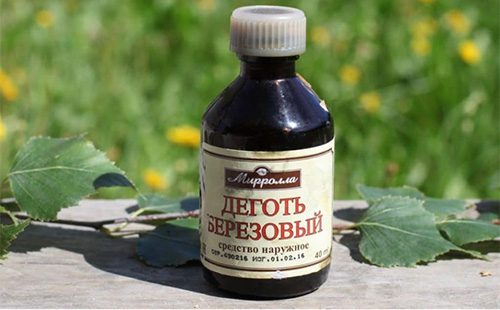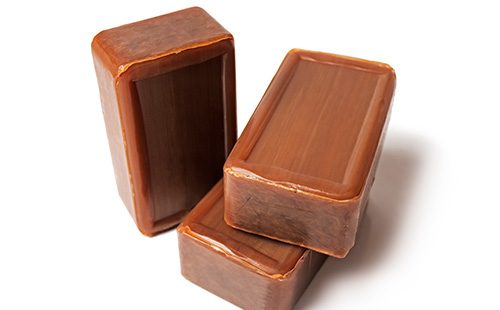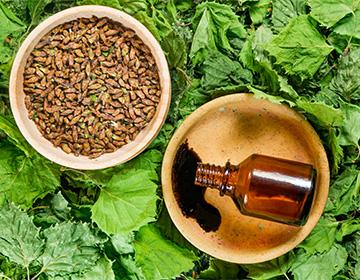The content of the article
Tar is called a liquid product of wood processing by pyrolysis (dry distillation). In essence, it is a resin extracted from fresh or petrified wood raw materials. The birch product (birch bark, raw) is pure, and can be used in pharmacology. Whereas aspen, coal, tar (tar) - technical, are intended for construction, lubrication of machinery, leather processing.
Until the beginning of the last century, the drug was widely used in medicine. Herbalist, herbalist M. Nosal wrote that people use it externally for rubbing, destroying scabies mites. And also a few drops inside for the treatment of "contagious diseases." With the advent of corticosteroid drugs about 50 years ago, which made a breakthrough in the treatment of skin diseases, interest in the folk remedy decreased, but did not disappear at all.
Characteristics of a herbal remedy
Science is well aware of not only the positive characteristics of corticosteroid ointments, but also their disadvantages. For example, the effect on the human hormonal system. Birch bark has no such effect.
Production
The plant product is included in the State Pharmacopoeia of Russia, so the technique of its production is standardized. For production, birch bark is used - the outer layer of the birch bark, consisting of many plates of yellow or reddish hues.
High-quality raw materials are obtained from trees whose trunk diameter reaches 20 cm. It is boiled, collecting a separated oily liquid. It is dark, thick, with a characteristic "yuftian" smell (roughly rude skin is similar). In the light gives a bluish-green glow.
Pharmacological effects
Birch bark includes phenolic compounds, resins, aldehyde substances. Its composition includes:
- betulin;
- creosol;
- fidget;
- guaiacol.
The main active ingredient is betulin, up to 40% of the volume of the product. It has antiseptic, anti-inflammatory properties.
The complex of substances gives the plant product the following actions:
- keratoplastic (restores the structure of the skin);
- antiparasitic;
- antipruritic;
- drying;
- anesthetic;
- resolving.
Indications
In folk medicine, the drug is used to treat skin diseases:
- scabies;
- depriving;
- dropsy.
In the twentieth century, the effectiveness of the drug in the treatment of 12 diseases has been scientifically confirmed:
- psoriasis;
- eczema (microbial, subacute, chronic, seborrheic);
- atopic dermatitis;
- neurodermatitis;
- scalp seborrheaaccompanied by dandruff;
- body seborrhea, accompanied by acne;
- scabies;
- ichthyosis;
- alopecia;
- fungus of the skin, foot, nails;
- pyoderma;
- itchy skin.
Contraindications
Despite the fact that birch tar is used to treat skin diseases, it cannot be used in the acute phase of eczema, neurodermatitis, with the progression of psoriasis. Contraindications for use:
- pregnancy;
- kidney disease
- pronounced exudative process.
The tool is not used in children, is not applied to large areas of the lesion due to toxicity. It is caused by compounds of polycyclic carbohydrates and turpentine, the danger of which increases with increasing dosage of the drug, the duration of its use. A negative effect on the kidneys is manifested if the coverage area of the product is more than ¼ of the body surface. With prolonged use, symptoms of intoxication may occur:
- headache;
- nausea;
- vomiting
In children, intoxication occurs faster, therefore, despite the absence of obvious contraindications, dermatosis in pediatrics is not treated with birch tar.
It is forbidden to use antibiotics of the sulfonamide series and the substance of the phenothiazine group against the background of the use of the drug. This is associated with a high risk of increased photosensitivity.
There is an opinion that treatment with birch tar can lead to cancer. The assumption is based on the proven carcinogenic properties of a coal product. However, this has nothing to do with birch bark.
Disadvantages of using
The thick oily liquid has a pungent odor and a rich, almost black color. When applied to the skin, it gives it a brown tint. It is practically not absorbed, you need to remove it with a napkin. The longer it comes into contact with the skin, the more pronounced the trace remains at the site of application. Stains clothes, bedding.
Clinical trials
In 2011, the Russian pharmaceutical company Retinoids conducted clinical trials of the properties of birch tar, as well as the benefits and harm that the substance brings to the body. The task of scientists was to establish the effectiveness of the short-term course of use of the drug, its tolerance, side effects.
The tests involved 16 men and women aged 17-52 years with confirmed diagnoses:
- psoriasis (focal and common);
- eczema;
- atopic dermatitis.
The treatment technique differed from the traditional one, in which it is recommended to apply the substance twice a day (for a period of up to two hours) on the affected area under a bandage. Specialists chose a short-term application of the product (up to 30 minutes) once a day.
After the procedure, the product was washed off with warm water and soap. When dry skin occurred, urea moisturizers were used.The treatment of extensive body lesions with a general malaise of the patient included antihistamine, antitoxic drugs and vitamins.
Drug tolerance
In the course of the study, the following reactions of the body to a substance with external application were recorded.
- Aggravation at the beginning of treatment. In several patients, reddening of the treatment area, sharp peeling, formation or strengthening of cracks, and hyperkeratosis were observed. Moisturizers did not remove excessive dryness. The most pronounced symptoms were on the thin skin of the palms and fingers.
- Reduced response within three days. After the initial outburst, an improvement in the condition of patients and a clear positive dynamics were observed. Small papules disappeared, large plaques disintegrated into small ones with the formation of gaps of unaffected tissue. Peeling went away on the fourth day, the itch completely disappeared.
- Pigmentation - only in one patient. It is believed that the treatment of psoriasis, eczema with birch bark increases the photosensitivity of the skin, and forms a risk of hyperpigmentation. However, this effect was recorded in only one subject. Patients did not use light-protective agents and did not cover treatment areas with clothing.
results
Studies by Russian experts have provided interesting data on the use of birch bark in the treatment of psoriasis, dermatitis and other skin diseases. And also adjust the traditional instructions for its use.
- The dynamics are positive, but the result is controversial. Within a month, doctors observed a steady improvement in the condition of all patients, but only one managed to achieve a complete cure. In this patient, rashes on the face and scalp in 17 days completely disappeared. In the remaining patients, the positive dynamics slowed by the end of the month.
- The drug works not only locally. In four patients with extensive lesions of the body, the substance was applied only to pronounced foci, while small papules were not treated. Despite this, during treatment in two patients, such papules disappeared completely, while in the rest their number decreased noticeably, which made it possible to talk about the general effect of the substance on the body, its ability to remotely suppress inflammatory foci on the skin.
- The product is very dry skin. This was observed by all patients. Dry skin caused discomfort, the formation of painful cracks. When using birch tar, additional hydration, nutrition, and skin softening are necessary.
- The most pronounced effect in psoriasis. The remedy is effective in all forms of chronic dermatoses, however, with psoriasis it works best.

Application
Before using herbal remedies, it is recommended to check kidney function by passing a general urine test. Yes, the results of research by Russian experts indicate the absence of a negative effect of the drug on this body. But there is evidence that the prolonged use of birch bark (in the presence of large erosions on the skin) in large volumes leads to negative effects.
Signs of impaired renal function can not always be felt. Problems are identified in a laboratory study of urine, where protein and cylinders are detected. In air, the biomaterial becomes dark green.In case of kidney disease, a phytopreparation should not be used.
It is also important to consider five recommendations.
- Apply superficially. The consequences of using birch bark inside a science have not been studied. Even in collections of folk recipes there is no mention of which diseases it was recommended to drink the remedy. M. Nosal speaks about this in passing, but Soviet phytotherapists and scientists do not consider such a practice. In this case, it can be assumed that due to the toxicity of the drug for external use, drinking birch tar containing phenols, aldehydes and resins is dangerous.
- Do not use on mucous membranes.. The integument of the respiratory system, rectum, vagina is more permeable. When applying herbal remedies, the level of absorption of components increases significantly. Therefore, birch bark is not used to treat hemorrhoids, thrush, inflammatory diseases of ENT organs. The drug is not recommended for use in tampons by the intracavitary method.
- Check individual tolerance. Before first use, do an allergy test. To do this, apply the product on a healthy skin area for 15 minutes. Abrupt redness, peeling and swelling - speak of individual intolerance.
- Do not use during exacerbation. In medical practice, the therapeutic method of Z. Pyankova is described, which rubbed the product into eczema-affected areas against the background of an exacerbation of the disease. At the same time, there was a sharp edema, increased wetness, which were stopped by other drugs, and soon the inflammation subsided. But such techniques can only be carried out under the supervision of a doctor, otherwise there is a great risk of aggravating the situation.
- Rub with a tool. For application use a hard brush or fabric "mushroom" made of gauze with a fabric folded inside in several layers. With hyperkeratosis, the agent is rubbed into the plaques with a stiff brush.
Psoriasis, eczema, neurodermatitis
Features The tool is rubbed into the affected areas in a pure form. According to L. Mashkillayson, author of the book “Treatment and Prevention of Skin Diseases,” clean birch bark is better tolerated by patients than formulations based on it. Adverse reactions occur many times less than when using multicomponent ointments.
Equipment
- Apply the product with a brush or fabric “mushroom”.
- Leave on for 15-30 minutes.
- Remove residues with a gauze swab dipped in vegetable oil.
- Repeat applications daily or every other day, increasing contact time to two to three hours.
Focal hair loss, seborrhea
Features Treatment is carried out with a pure composition or a combination of birch bark with alcohol - mixed in equal parts. A good effect is demonstrated by a mixture of tar with glycerin (1: 1).
Equipment
- Apply the product to the hair roots with a cotton pad.
- Rub into the scalp with a stiff brush.
- Wipe up any residue with a tissue.
- Use the drug every other day, alternating with shampooing.

Chronic plaque skin inflammation
Before applying the drug, hyperkeratotic formations must be softened. For this, the patient is prescribed a warm bath, which should be taken up to 40 minutes. Only then tar is rubbed. The next day, the procedure is repeated.
In case of psoriasis, it is not recommended to wash off the product, you just need to wash the remains with a cotton swab. With eczema, water procedures should be alternated according to the scheme:
- warm bath - removal of scabs and scales;
- application of funds - application for one hour;
- warm bath - removal of residues with soapy water.
This technique is also effective for diseases caused by skin parasites (scabies mites) and candida fungus.
Birch bark is used in cosmetology. It is introduced into the composition of shampoos for oily scalp, against dandruff. Add to acne remedies with anti-inflammatory, keratoplastic activity. But in its pure form, in cosmetic procedures, tar is never used, since it leaves dark marks on the skin, and the treated areas are at risk of pigmentation.

